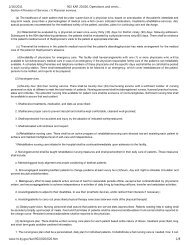State Regulations Pertaining to Dietary Sanitation & Environmental ...
State Regulations Pertaining to Dietary Sanitation & Environmental ...
State Regulations Pertaining to Dietary Sanitation & Environmental ...
You also want an ePaper? Increase the reach of your titles
YUMPU automatically turns print PDFs into web optimized ePapers that Google loves.
. Equipment and utensils shall be thoroughly washed in a detergent solution having a temperature<br />
of at least 110 degrees Fahrenheit, and then shall be rinsed free of such solution. All eating and<br />
drinking utensils and, where required, the food-contact surfaces of all other equipment and utensils<br />
shall then be sanitized by one of the following methods:<br />
1. Immersion for at least one-half minute in clean hot water at a temperature of at least 170 degrees<br />
Fahrenheit.<br />
2. Immersion for at least one minute in a clean solution containing at least fifty parts per million of<br />
available chlorine as a hypochlorite and at a temperature of at most 75 degrees Fahrenheit.<br />
3. All chemicals used for sanitizing shall have complete instructions for use kept in the cleaning<br />
area.<br />
c. When chemical sanitizing solutions are used for either manual or mechanical sanitization,<br />
procedures for testing shall be provided and used <strong>to</strong> measure the residual of the sanitizing chemical<br />
solution used at least daily.<br />
18.L.3. Mechanical Cleaning and Sanitizing<br />
a. Warewashing machines and their auxiliary components shall be operated in accordance with<br />
manufacturers' instructions and procedures for testing shall be provided and used.<br />
b. When chemicals are relied upon for sanitization, they shall be applied in such concentration and<br />
for such a period of time as <strong>to</strong> provide effective bactericidal treatment of the equipment and<br />
utensils:<br />
1. The temperature of the wash water shall not be less than 120 degrees Fahrenheit.<br />
2. Chemicals added for sanitization purposes shall be au<strong>to</strong>matically dispensed.<br />
3. The chemical sanitizing rinse water temperature shall be the temperature specified by the<br />
machine manufacturer.<br />
c. Dishwashing racks, when not in use, shall be s<strong>to</strong>red in a clean area off the floor.<br />
18.L.4. Equipment and Utensil Handling and S<strong>to</strong>rage<br />
a. Cleaned and sanitized equipment and utensils shall be handled in a way that protects them from<br />
contamination. Tableware shall be handled without contact with inside surface or surfaces that<br />
contact the user's mouth.<br />
b. Cleaned and sanitized utensils and equipment shall be s<strong>to</strong>red at least six inches above the floor in<br />
an enclosed, clean, dry location and protected from contamination by splash, dust, and other means.<br />
Equipment and utensils shall not be placed under exposed or unprotected sewer lines or water<br />
lines, except for au<strong>to</strong>matic fire protection sprinkler heads that may be required by law.<br />
c. Cleaned utensils shall be s<strong>to</strong>red covered, inverted or appropriately s<strong>to</strong>red on utensils racks.<br />
d. Facilities for the s<strong>to</strong>rage of knives, forks, and spoons shall be designed and used <strong>to</strong> present the<br />
handle <strong>to</strong> the employee, resident or user.<br />
Page 23 of 74



